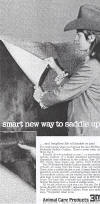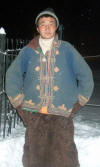The
Long Riders’ Guild became alarmed in 2005 when horses belonging to equestrian
explorers were injured after being fitted with what was being billed as the “no
sweat pad” in America and the “cool breeze” saddle pad in England.
This
international equestrian scandal was accidentally exposed when a British Long
Rider discovered the “saddle pad” lying in front of a Chilean supermarket, where
it was being used in its original application as a door mat. During the
subsequent inquiry Long Riders in five countries discovered that a 3M product
known as “Wet Area Matting 1500” was being knowingly sold by the corporation to
individuals who then cut the coarse synthetic material into saddle sized pieces.
The disguised floor mat, which 3M describes as being suitable for high traffic
areas in sports centres, hotels and hospitals, was then remarketed as expensive
saddle pads in the United States, England and Australia.
When
contacted by The Long Riders’ Guild, a 3M spokesman at the company’s corporate
headquarters in St. Paul, Minnesota confirmed that the company knew horses were
being scarred and injured by the misuse of their product. However, despite the
Guild’s request that the company issue a public warning to horse owners
worldwide, the 3M Corporation refused to acknowledge these documented concerns.
Nor would the corporation admit that in the 1970s it had sold the bath mat under
the guise of a saddle pad. Instead the company’s website was altered and
incriminating photographs which might link the floor mat to the so-called saddle
pad were removed by 3M.
Shortly thereafter an American Long Rider discovered a 3M advertisement which
had been placed in Western Horseman magazine in 1971. It clearly showed the fake
saddle pad being peddled to an unsuspecting public. The 3M Corporation has never
admitted their original actions nor ceased their on-going participation in this
misleading equestrian practice.
The Mongol Derby
In
2008 the Long Riders' Guild received an unsolicited email from a representative
of the Adventurists, a company based in England that
specialized in enticing
adventure-hungry tourists into paying large sums of money to race junk cars to
distant national capitals.
Though they lacked any equestrian
experience, the
Adventurists wrote to say they were now planned to launch
the largest non-sanctioned endurance race ever attempted. Nearly a thousand
Mongolian horses had been drafted to run in a thousand kilometre long race which
deliberately flaunted international endurance racing rules. To ensure a hefty
profit, the company had charged twenty-five foreign contestants from America,
England, New Zealand and other countries nearly $5,000 each to participate.
The Guild, alarmed at the company’s shocking disregard for safety and ethics,
responded by explaining why the proposed event would result in injuries to the
horses and riders. Those Long Riders who had intimate first hand knowledge of
Mongolia offered their advice and assistance. The Guild concluded by warning the
Adventurists that the poorly-planned event would become a lightning-rod of
concern. The Adventurists did not accept the Guild's offers of assistance, nor
heed the warning.
Instead they released a public statement which bragged,
"It's dangerous, it's unsupported and you could die."
The company’s website also stated, “The Mongol Derby will see you tackle the
challenge of semi-wild horses and surviving alone in the wild steppes of
Mongolia. There’s no carefully marked course, no catering tent and no support;
this is horse racing on a whole new scale. You will change steeds every 40 km so
the horses will be fresh. Bleeding kidneys, broken limbs, open sores, moon
stroke and a list of dangers longer than your arm stand between you and
victory….You
will have to navigate your way from one station to the next single-handedly;
there's no marked course and there will be huge stretches with no paths or
tracks at all. In fact even when there are tracks there is little chance they
will be going in the right direction. You will be facing the wilderness alone,”
touted the race organizers, who described the outlaw race as the “biggest,
baddest equine affair on the planet.”
Contestant Hannah Ritchie told the
press, “There is no marked course, no roads or tracks, we must find our own
water and depend on the hospitality of the nomadic people we encounter
along the way for food and shelter.”
As
predicted, when it became known that the Adventurists planned to flaunt such
basic rules as providing water for the horses and a marked course for the
competitors, the proposed race created an equestrian fire-storm of protest, with
editors, endurance racers, Long Riders and mainstream explorers, all joining
their voices in an unprecedented condemnation of the dubious event.
At
first the Adventurists scoffed at the criticism, circulating a press release
wherein they posed the question, “I hope this email finds you revving up for a
weekend of adventuring anarchy, drunken debauchery and general misdemeanours.”
During the ensuing months the Mongol Derby became a battleground over equestrian
ethics, with an unprecedented international protest being raised about the
welfare of the horses, the last minute financial involvement of a discredited
foreign ruler and the revelation that the race organizers secretly paid the only
Mongolian rider to participate and – according to him – then robbed him of his
victory.
Horse-lovers from 26 nations added their voices to the international petition
aimed at stopping the unethical Mongol Derby from being run. Letters of protest
were sent to
Mongolian President Tsakhiagin Elbegrorj, Princess Haya, the President of the
Fédération Internationale Equestre and James Fitzpatrick, the British Minister
of Horses.
As a result of the intense pressure
brought about by the Guild’s campaign, the company relented. Though the route of
the race was kept secret from the public and the press, veterinarians were
eventually provided to protect the welfare of the horses and basic safety
procedures were established for the riders.
During the lead-up to the race there
had been questions raised about how Mongolia was being used to foster a new type
of equestrian colonialism. To offset this specific criticism, three days before
the race was due to begin the name of a Mongolian was suddenly listed as being a
contestant. Unlike the twenty-five foreign riders, no hint was offered as to who
this person was, what his equestrian experience consisted of, nor how he had
managed to raise the large sum of money required of the other contestants. Only
the name of the final contestant was presented to the public. Why? Only the
Adventurists knew.
On August 29th the
Adventurists website reported, “First across the line was the Mongolian Rider,
followed only one minute later by the South African, Charles Van Wyk. “ Yet six
days later the company retracted that statement. Shiravsamboo Galbadrakh,
the Mongolian winner of the race, was air-brushed out when the Adventurists
declared that
the South African rider, who had
strong commercial ties to the Barefoot Saddle Company which provided free
saddles to the contestants, had been the winner.
Temuujin Zemuun is Mongolia’s first
modern Long Rider. He journeyed across Mongolia to find
Shiravsamboo Gulbadrakh, the illiterate young shepherd who had been recruited by
the Adventurists to ride in the notorious race.
Gulbadrakh said agents of the Adventurists had deliberately sought him out three
days prior to the start of the race. He had not been told that the foreign
contestants had paid large sums of money to participate. Instead the company
representatives secretly paid the unmarried Mongolian shepherd to take part in
the race.
He did not know that the Adventurists claimed that the foreign contestant who
came in second was later declared the co-winner. Shiravsamboo insisted that he
won all by himself and was adamant that he is the sole winner.
Though the entire equestrian world,
both supporters and detractors, had been watching events from afar, no photos
have ever been made available showing which rider was actually first across the
finish line. Instead the Mongolian was removed in favour of the professional
endurance rider from South Africa who basked in the glory.
Home

